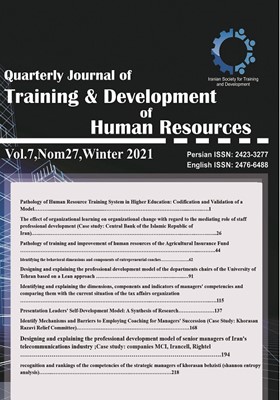-
-
List of Articles
-
Open Access Article
1 - Presentation Leaders' Self-Development Model: A Synthesis of Research
mahdi sahraei beiranvand Gholamreza Shams Morkani Abasalt Khorasani Mohammad sadegh Khayatian yazdi -
Open Access Article
2 - Identifying the behavioral dimensions and components of entrepreneurial coaches
Mohammad Azizi hamid hosseinlo yousef vakili -
Open Access Article
3 - Identify Mechanisms and Barriers to Employing Coaching for Managers' Succession (Case Study: Khorasan Razavi Relief Committee)
Farzad Mashhadi Davood Ghorooneh -
Open Access Article
4 - Identifying and explaining the dimensions, components and indicators of managers' competencies and comparing them with the current situation of the tax affairs organization
Ahmad Ali Sadeghi Mohamad Ali Hosseni kamran mohammad khani -
Open Access Article
5 - The effect of organizational learning on organizational change with regard to the mediating role of staff professional development (Case study: Central Bank of the Islamic Republic of Iran)
Manijeh Ahmadi Samad Barani -
Open Access Article
6 - Designing and explaining the professional development model of the departments chairs of the University of Tehran based on a Lean approach
mojtaba hajkhozeymh Khodayar Abili javad pourkarimi -
Open Access Article
7 - Designing and explaining the professional development model of senior managers of Iran's telecommunications industry Case study: companies MCI, Irancell, Rightel
Saeed Hadavand Afsaneh Zamanimoghadam Ali Taghipoorzahir -
Open Access Article
8 - recognition and rankings of the competencies of the strategic managers of khorasan behzisti (shannon entropy analysis)
kazem Nasirpour Moslem Cherabin Ahmad Akbari Davoud Kaveh -
Open Access Article
9 - Pathology of Human Resource Training System in Higher Education: Codification and Validation of a Model
Khaled Mirahmadi Abasalt Khorasani Mohammad taghi Nazarpour Gholamreza Shams Murkani -
Open Access Article
10 - Pathology of training and improvement of human resources : The case of the insurance organization
Talat Diba Vajari Frouz Nouri
-
The rights to this website are owned by the Raimag Press Management System.
Copyright © 2017-2025







